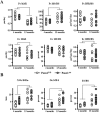Age- and sex-dependent role of osteocytic pannexin1 on bone and muscle mass and strength
- PMID: 31554905
- PMCID: PMC6761284
- DOI: 10.1038/s41598-019-50444-1
Age- and sex-dependent role of osteocytic pannexin1 on bone and muscle mass and strength
Abstract
Pannexins (Panxs), glycoproteins that oligomerize to form hemichannels on the cell membrane, are topologically similar to connexins, but do not form cell-to-cell gap junction channels. There are 3 members of the family, 1-3, with Panx1 being the most abundant. All Panxs are expressed in bone, but their role in bone cell biology is not completely understood. We now report that osteocytic Panx1 deletion (Panx1Δot) alters bone mass and strength in female mice. Bone mineral density after reaching skeletal maturity is higher in female Panx1Δot mice than in control Panx1fl/fl mice. Further, osteocytic Panx1 deletion partially prevented aging effects on cortical bone structure and mechanical properties. Young 4-month-old female Panx1Δot mice exhibited increased lean body mass, even though pannexin levels in skeletal muscle were not affected; whereas no difference in lean body mass was detected in male mice. Furthermore, female Panx1-deficient mice exhibited increased muscle mass without changes in strength, whereas Panx1Δot males showed unchanged muscle mass and decreased in vivo maximum plantarflexion torque, indicating reduced muscle strength. Our results suggest that osteocytic Panx1 deletion increases bone mass in young and old female mice and muscle mass in young female mice, but has deleterious effects on muscle strength only in males.
Conflict of interest statement
The authors declare no competing interests.
Figures








References
-
- Barbe MT, Monyer H, Bruzzone R. Cell-cell communication beyond connexins: the pannexin channels. Physiology. (Bethesda.) 2006;21:103–114. - PubMed
Publication types
MeSH terms
Substances
Grants and funding
- R01 CA194593/CA/NCI NIH HHS/United States
- R01 AR053643/AR/NIAMS NIH HHS/United States
- T32 AR065971/AR/NIAMS NIH HHS/United States
- I01 BX004177/BX/BLRD VA/United States
- 3R01AR067210-03S1/U.S. Department of Health & Human Services | NIH | National Institute of Arthritis and Musculoskeletal and Skin Diseases (NIAMS)/International
LinkOut - more resources
Full Text Sources
Molecular Biology Databases
Miscellaneous

